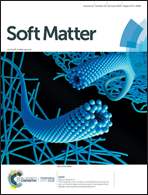Polyamine-induced, chiral expression from liquid crystalline peptide nanofilaments to long-range ordered nanohelices†
Abstract
We reported the condensation and transformation of peptide micelles into well-defined nanohelices through the incorporation of natural polyamines. The liquid-crystalline peptide micelles are assembled by a short dipeptide amphiphile driven by strong electrostatic repulsions and aromatic stacking attractions. By incorporating polyamines into the peptide solutions, like-charge attractions were achieved to induce the condensation of the like-charged nanofilaments into giant bundles. Intriguingly, by increasing the temperature or electrostatic screening effects, the nanofilaments within the bundles fuse with each other into well-defined flat ribbons which then spontaneously twisted into macroscopically aligned nanohelices. Moreover, the chiral interactions between the aromatic groups of adjacent peptides are inverted from right-handedness to left-handedness during the formation of nanohelices. The results provide new insights into the chiral evolution during peptide self-assembly and offer opportunities for the design of peptide materials with new properties, such as anisotropic hydrogels and long-range ordered chiral nanostructures.



 Please wait while we load your content...
Please wait while we load your content...